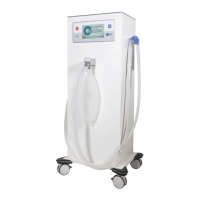– 7 –
Contraindications:
(rhinitis, sinusitis)
personality disorders
bubble
- Consequence: neither employees of the dental
practice nor patients in the
rst or second trimesters may be exposed to nitrous
oxide
- Third trimester of pregnancy: Use following
careful indication
- Please note: in Sweden, 90% of mothers use nitrous
oxide during labour.
Nitrous oxide diuses into hollow spaces. Accordingly, it
should not be inhaled following a middle ear infection,
an intestinal obstruction, an eye operation with intraoc-
ular gas bubble, etc. In the last instance, for example, this
could lead to loss of sight or, at least, an unpleasant feel-
ing of pressure. Always take a medical history and observe
the content conveyed in the advanced training course.
Indications:
gag/swallowing reex
problems and asthma
Side eects:
The general side eects of nitrous oxide are very minor,
e.g. vitamin B12 deciency In case of continuous admin-
istration over two days.
Cardiovascular side eects:
Respiratory eects:
consider other forms of anaesthesia
No eect on:
the body
Complications of overdose
Precisely because of the risk of oversedation (e.g. light-
headedness, increase in pulse rate, discomfort), the prac-
titioner must be precisely trained on how to individually
titrate the nitrous oxide. In case of oversedation, either
reduce the nitrous oxide or press the O
2
ush button to
deliver 40-55 litres/minute of oxygen into the breathing
bag. Nitrous oxide is easy to control and has a rapid o-
set, i.e. oversedation passes quickly.
Nausea and vomiting:
combination with other anaesthetics/analgesics
therefore only administer more than 50% nitrous ox-
ide in exceptional cases. The average patient is already
optimally sedated at approx. 30-40% nitrous oxide.
important to turn his head to the side so there is no
risk of aspiration.
2. INDICATIONS, CONTRAINDICATIONS
AND SIDE EFFECTS

